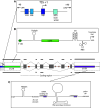Regulation of eukaryotic gene expression by the untranslated gene regions and other non-coding elements
- PMID: 22538991
- PMCID: PMC3474909
- DOI: 10.1007/s00018-012-0990-9
Regulation of eukaryotic gene expression by the untranslated gene regions and other non-coding elements
Abstract
There is now compelling evidence that the complexity of higher organisms correlates with the relative amount of non-coding RNA rather than the number of protein-coding genes. Previously dismissed as "junk DNA", it is the non-coding regions of the genome that are responsible for regulation, facilitating complex temporal and spatial gene expression through the combinatorial effect of numerous mechanisms and interactions working together to fine-tune gene expression. The major regions involved in regulation of a particular gene are the 5' and 3' untranslated regions and introns. In addition, pervasive transcription of complex genomes produces a variety of non-coding transcripts that interact with these regions and contribute to regulation. This review discusses recent insights into the regulatory roles of the untranslated gene regions and non-coding RNAs in the control of complex gene expression, as well as the implications of this in terms of organism complexity and evolution.
Figures

Similar articles
-
Protein-coding structured RNAs: A computational survey of conserved RNA secondary structures overlapping coding regions in drosophilids.Biochimie. 2011 Nov;93(11):2019-23. doi: 10.1016/j.biochi.2011.07.023. Epub 2011 Jul 31. Biochimie. 2011. PMID: 21835221
-
The evolution of RNAs with multiple functions.Biochimie. 2011 Nov;93(11):2013-8. doi: 10.1016/j.biochi.2011.07.018. Epub 2011 Jul 23. Biochimie. 2011. PMID: 21802485
-
Cis-acting noncoding RNAs: friends and foes.Nat Struct Mol Biol. 2012 Nov;19(11):1068-75. doi: 10.1038/nsmb.2428. Nat Struct Mol Biol. 2012. PMID: 23132386 Review.
-
Purifying selection acts on coding and non-coding sequences of paralogous genes in Arabidopsis thaliana.BMC Genomics. 2016 Jun 13;17:456. doi: 10.1186/s12864-016-2803-2. BMC Genomics. 2016. PMID: 27296049 Free PMC article.
-
Variation in the Untranslated Genome and Susceptibility to Infections.Front Immunol. 2018 Sep 7;9:2046. doi: 10.3389/fimmu.2018.02046. eCollection 2018. Front Immunol. 2018. PMID: 30245696 Free PMC article. Review.
Cited by
-
Unlocking the diagnostic, prognostic roles, and immune implications of BAX gene expression in pan-cancer analysis.Am J Transl Res. 2024 Jan 15;16(1):63-74. doi: 10.62347/TWOY1681. eCollection 2024. Am J Transl Res. 2024. PMID: 38322551 Free PMC article.
-
miRGate: a curated database of human, mouse and rat miRNA-mRNA targets.Database (Oxford). 2015 Apr 8;2015:bav035. doi: 10.1093/database/bav035. Print 2015. Database (Oxford). 2015. PMID: 25858286 Free PMC article.
-
Dynamics of Whole Transcriptome Analysis (WTA) and Surface markers expression (AbSeq) in Immune Cells of COVID-19 Patients and Recovered captured through Single Cell Genomics.Front Med (Lausanne). 2024 Jan 31;11:1297001. doi: 10.3389/fmed.2024.1297001. eCollection 2024. Front Med (Lausanne). 2024. PMID: 38357647 Free PMC article.
-
LINC00511 Promotes Osteosarcoma Tumorigenesis and Invasiveness through the miR-185-3p/E2F1 Axis.Biomed Res Int. 2020 Sep 9;2020:1974506. doi: 10.1155/2020/1974506. eCollection 2020. Biomed Res Int. 2020. Retraction in: Biomed Res Int. 2024 Mar 20;2024:9802014. doi: 10.1155/2024/9802014. PMID: 32964019 Free PMC article. Retracted.
-
Promoter activity and transcriptome analyses decipher functions of CgbHLH001 gene (Chenopodium glaucum L.) in response to abiotic stress.BMC Plant Biol. 2023 Feb 27;23(1):116. doi: 10.1186/s12870-023-04128-8. BMC Plant Biol. 2023. PMID: 36849913 Free PMC article.
References
-
- Amaral PP, Dinger ME, Mercer TR, Mattick JS. The eukaryotic genome as an RNA machine. Science. 2008;319:1787–1789. - PubMed
-
- Andreassi C, Riccio A. To localize or not to localize: mRNA fate is in 3′UTR ends. Trends Cell Biol. 2009;19:465–474. - PubMed
-
- Arce L, Yokoyama NN, Waterman ML. Diversity of LEF/TCF action in development and disease. Oncogene. 2006;25:7492–7504. - PubMed
Publication types
MeSH terms
Substances
LinkOut - more resources
Full Text Sources
Other Literature Sources

